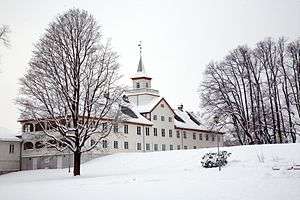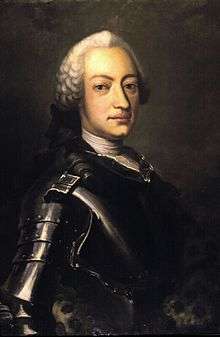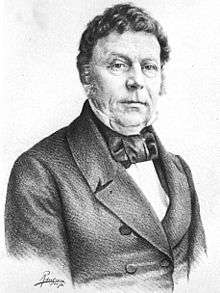Frogner Manor


Frogner Manor (Frogner Hovedgård) is a manor house and former estate in today's borough of Frogner in Oslo, Norway. The estate comprised most of the modern borough of Frogner, which has been named after the estate, and Frognerseteren with parts of the Nordmarka forest (Frognerseterskogen). The remaining part of the estate is now the site of the Frogner Park, with the manor house found in the south of the park and the Vigeland installation in the park's centre. The 18th century buildings on the grounds are now occupied by the Oslo Museum.
Frogner was one of the largest and oldest agricultural properties in the Oslo area. In the Middle Ages, Frogner became ecclesiastical property, mostly owned by the Hovedøya Abbey, but was confiscated by the Crown in 1532, preceding the Reformation. From the mid 17th century to the late 19th century, it was owned by wealthy officials or burghers of Christiania, but it was sold to the municipality of Kristiania in 1896 to make room for urban expansion and a new cemetery (Vestre gravlund). However, significant parts of the estate instead became a public park.
History
Frogner Manor was built in 1750 by Major Hans Jacob Scheel (1714-1774), the first owner to make Frogner his permanent residence. In 1790 the estate was bought by timber merchant and shipowner Bernt Anker (1746–1805), Norway's richest person at the time. He extended the main building to its present size. He died a childless widower in 1805, and Frogner was bought by his nephew Morten Anker in 1807. His business was hard hit by the economic depression during and after the Napoleonic wars, and he eventually went bankrupt and was forced to sell Frogner by auction in 1836. The buyer was the director-general of the Modum Blue Colour Works, Benjamin Wegner, who was married to Henriette Seyler of the Hamburg Berenberg banking dynasty.[1] [2]
In 1848 Fredrik Georg Gade (1807–59), a wealthy merchant from Bergen, purchased the manor. His heirs held the property in joint ownership, under the management of his son Gerhard Gade (1839–1909). He was married to an American, Hellen Allyne, and was the United States consul in Oslo.[3] The former U.S. president and general Ulysses S. Grant visited Kristiania in the summer of 1878, and attended a gala dinner at Frogner with his entourage.[4][5]
Major parts of the farmland belonging to the manor was sold and built up through the end of the 19th century as the city expanded, but around one square kilometer remained when the city of Oslo bought the property in 1896 to secure space for further urban development and a new cemetery. The last private owner, Gerhard Gade, retained the right to inhabit the house until his death in 1909. This spared the house from demolition, and an economic recession prevented further building on the land.[6]
In the meantime, the house was recognised as an important cultural monument. It was restored and placed at the disposal of the Oslo City Museum.
Frogner Park

The private garden surrounding the manor house was historically much smaller. After Oslo municipality acquired the estate, much of the remaining agricultural land was turned into a public park, the Frogner Park, with Gustav Vigeland's sculpture arrangement (Vigelandsanlegget or the Vigeland installation) erected in the centre from 1928 to 1943. In 1914 the area was the site of the 1914 Jubilee Exhibition.
Frognerseteren
The seter (mountain dairy farm) of Frogner was situated near the summit of the Holmenkollen hill north of Oslo, and included parts of the Nordmarka forest. The name is still preserved in the terminal Frognerseteren station of the suburban Holmenkoll Line, opened in 1898 and extended in 1916. Frognerseteren and the forest was split from Frogner Manor when Benjamin Wegner sold the manor but kept Frognerseteren in 1848. Wegner's heirs sold it to Thomas Johannessen Heftye in 1864, and his heirs sold it to the municipality in 1889, thus making it the first forest owned by Oslo municipality.[7]
Etymology
The Norse form of the name was Fraunar (plural form). The name is probably derived from the word frauð 'manure' - and then with the meaning 'fertilized fields'.
People
 Selius Marselis (1600-1663)
Selius Marselis (1600-1663) Karen Toller, married Hausmann, (1662-1744)
Karen Toller, married Hausmann, (1662-1744)- Anne Cathrine Toller, married Tritzschler and Garmann

 Hans Ernst von Tritzschler (1647-1718)
Hans Ernst von Tritzschler (1647-1718)- Ulrik Frederik de Cicignon (1698-1772)
 Hans Jacob Scheel (1714–1774)
Hans Jacob Scheel (1714–1774)- Bernt Ancher Sverdrup (1734–1809)
 Bernt Anker (1746-1805)
Bernt Anker (1746-1805) Mathia Anker (1737–1801), née Collett, wife of Bernt Anker
Mathia Anker (1737–1801), née Collett, wife of Bernt Anker- Morten Anker (1780–1838)
 Benjamin Wegner (1795-1864)
Benjamin Wegner (1795-1864).jpeg) Henriette Wegner (1805–1875), née Seyler, wife of Benjamin Wegner
Henriette Wegner (1805–1875), née Seyler, wife of Benjamin Wegner
References
- ↑ Wegner, R. B.: Familien Wegner, Halden 1963, pp. 22-72.
- ↑ "Hans Jacob Scheel (1714-1774)". Lokalhistoriewiki. Retrieved January 25, 2016.
- ↑ Gade, John A.: All My Born Days, New York 1942, Scribner, pp. 1-28.
- ↑ Gade, Ingeborg: Stamtavle over slegterne Gade og Wallem, Kristiania 1921, p.56-57.
- ↑ "Gade". Store norske leksikon. Retrieved January 25, 2016.
- ↑ Frogner Manor (Oslo Museum)
- ↑ Andreas Vevstad: Det begynte med Frognerseterskogen: Oslo kommunes skoger 1889–1989. Aschehoug, 1989
| Wikimedia Commons has media related to Frogner Hovedgård. |
Other sources
- Magnussen, Kjeld (1967) Gaarden Store Frogner (Oslo: Bymuseum)
- Gade, Ingeborg (1921) Stamtavle over slegterne Gade og Wallem (Kristiania: Det Mallingske Bogtrykkeri)
- Gade, John A. (1942) All My Born Days. Experiences of a Naval Intelligence Officer in Europe (New York, Charles Scribner's Sons)
- Wegner, R. B.(1963) Familien Wegner (Halden)
Coordinates: 59°55′27.41″N 10°42′10.98″E / 59.9242806°N 10.7030500°E